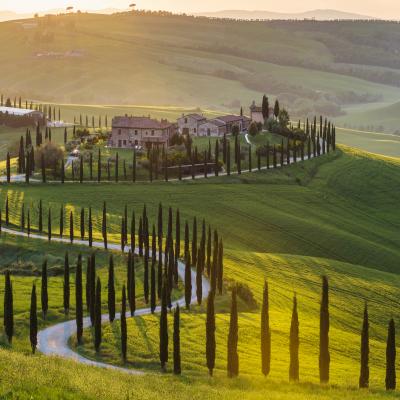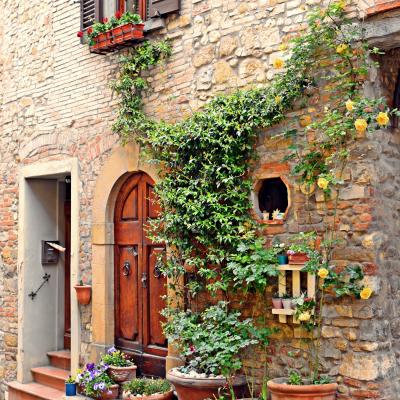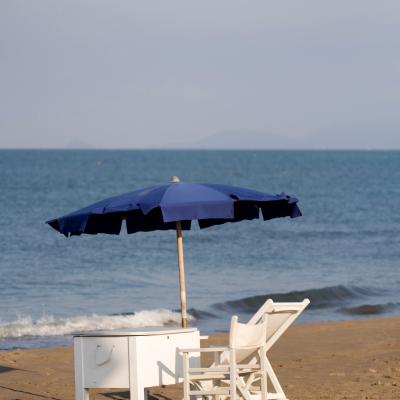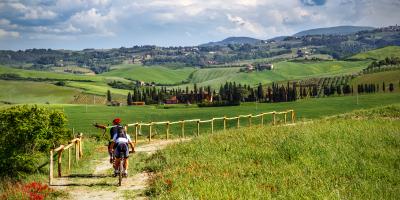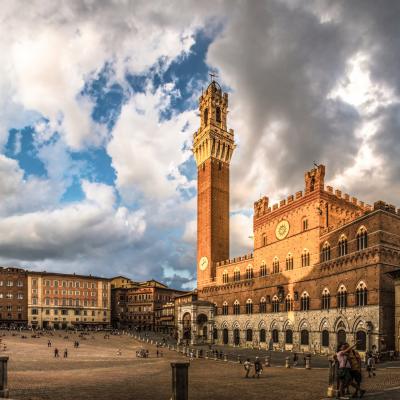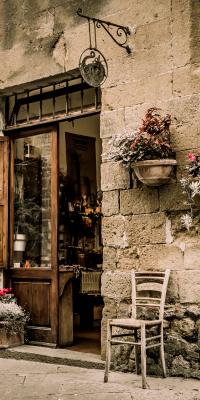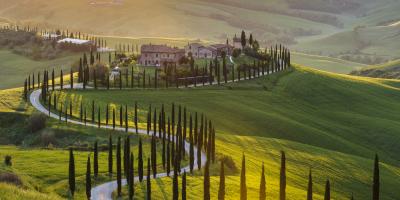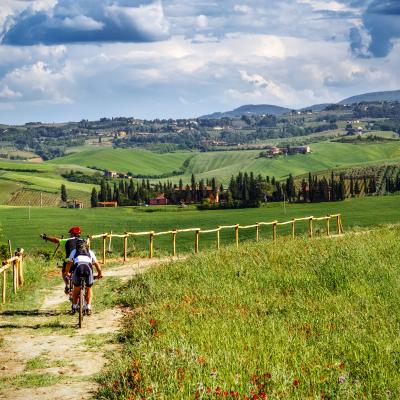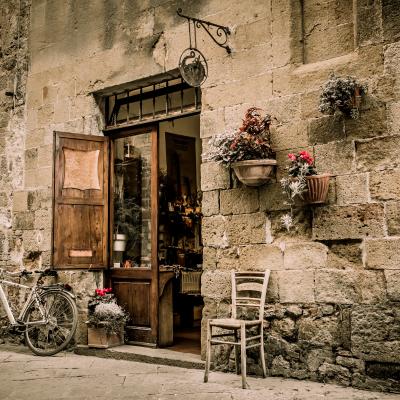Tuscany
Thanks to its history and strong cultural and linguistic unity, it is one of the Italian regions with the oldest and most defined identity, so much so that it is considered by some to be a true "nation." The name is very old and derives from the ethnonym used by the Greeks and Latins to define the land inhabited by the Etruscans: "Etruria," later transformed into "Tuscia" and then "Tuscany."
Tuscany is sea, mountains, countryside, spas and art. It is one of the most beloved regions for foreign tourists, prolific of exceptional artistic and food and wine inspirations thanks to the dense network of Strade del Gusto (Taste Roads) scattered throughout the territory and masterpieces of strong international appeal, one above all Michelangelo's David, one of the most fanatical sculptures in the world. The sea prides itself on the presence of the seven jewel-islands of the Tuscan Archipelago (Elba, Giglio Island, Montecristo, Capraia, Pianosa, Giannutri and Gorgona), the beaches of Maremma, the Apuan Riviera and Argentario; nature explodes lushly in Mugello, Versilia, Vallombrosa, the Apennines where Abetone stands out, and among the Apuan Alps, to slope gently into the relaxing landscapes of the hills where Chianti is produced, but not only. There are the hills of Pisa, those of San Miniato, the Val di Sieve and Val di Cecina, there is the Val d'Orcia, the Val di Chiana, the Orbetello lagoon and other green oases. Tuscany is relaxation that has made Italian spa history: from Montecatini to Chianciano, from Bagni di Lucca to Terme di San Giuliano, the region's spa network includes 14 state-of-the-art resorts for stays focused on the health of body and soul. Cradle of the Italian Renaissance, Florence and its historic center, a UNESCO World Heritage Site, would be enough on its own to cover the history of the entire country. But unique treasures are scattered in the region's other cities of art, from Lucca to Livorno, from Siena to Arezzo, from Pisa to Massa-Carrara, not to mention the smaller villages with medieval charm and the fortified citadels scattered almost everywhere in the territory.
Florence
Florence is a magical, romantic and absolutely unparalleled city in the world, not only because of its museums and works of art but because of the climate you can breathe when visiting it, following its rhythms, savoring its scents and flavors.
It is the Capital of Renaissance Art and beyond. A city that has maintained its charm and splendor of the past, it never ceases to amaze, with its masterpieces of art, the colorful marbles of the churches and the architecture that recall its splendor and the role it played in the development of Renaissance culture and art. Florence offered the whole world a stage that great artists such as Michelangelo, Brunelleschi, and Leonardo da Vinci exploited to make their works and creative genius known.
Brunelleschi's Dome dominates Florence and even today there is no taller building in the entire city. The Campanile was designed by Giotto although he did not see it finished. The Baptistery is one of the oldest buildings in Florence and has been there since the 4th century; with its magnificent doors it is a true picture Bible. The Duomo with its white and green marble facade enraptures the eye. Nowhere else in the world is there such an extraordinary complex of buildings. We are in the heart of Florence, in front of Santa Maria del Fiore, which everyone calls Duomo. The most beautiful bridge in Florence and one of the most photographed in the world, it has not always been a chic place. Although today it is the goldsmiths' stores that attract caravans of tourists, until 1565 it was the vegetable and butchers' stores that dominated the bridge. When the Uffizi's Vasari Corridor overlooking Ponte Vecchio was built, the butchers and vegetable vendors were dislodged in favor of goldsmiths and artisans, who were deemed more appropriate trades for the beauty of the place.
A Caravaggio enters, a Raphael leaves. A Titian leaves for an exhibition abroad but meanwhile Rosso Fiorentino's (famous) angels return. Such are the Uffizi, a kind of art supermarket, a treasure trove of masterpieces from every century and a dream destination for art lovers around the world. Michelangelo's tomb, "protected" by three sculptures representing Painting, Sculpture and Architecture, contends with the first part of the Basilica of Santa Croce with the tomb of Galileo Galilei, located just opposite. In 1784 the Galleria dell'Accademia was built at the behest of Grand Duke Pietro Leopoldo to introduce the great examples of Florentine art to the students of the nearby Academy of Fine Arts. It just wasn't possible for the churches of Santo Spirito and Santa Croce, belonging to the Augustinian and Franciscan friars respectively, to be the most beautiful and majestic in Florence, so the Dominican friars in 1278 began the construction of the Church of Santa Maria Novella, which became a wonderful example of "Tuscan Romanesque," thanks to the use of white, black and green marble.
Culture and UNESCO Sites
A land of surprising and multifaceted artistic, historical, cultural, monumental, and urban multiplicities, Tuscany revives for the visitor certain charms that accompanied Grand Tour travelers. The complex and rich culture that permeates any corner of Tuscany, returns a natural symbiosis between landscape and art, history and expressive forms of architecture and urban planning, between the urban and rural dimensions and its artistic, architectural, monumental and museum heritage. A synthesis of art in this region begins with the rock sites of Cetona, the stele statues of Lunigiana, the presences of ancient civilizations on the Island of Elba, and continues with the Etruscan necropolis, the tangible signs of the Roman past, the innumerable testimonies of the Middle Ages, the blossoming of the Gothic, the explosion of the Renaissance, the richness of the Baroque, the Macchiaioli, the advent of the floral or Art Nouveau style, to arrive at the artistic expressions chronologically closest to us.
Unesco Sites: Historic Center of Florence Piazza del Duomo in Pisa Historic Center of San Gimignano Historic Center of Siena Historic Center of Pienza Val d'Orcia
Pisa, the Tower and Piazza dei Miracoli
The 4 monuments that surround the Piazza dei Miracoli, and "form" it were built in different eras (from the 11th to the 14th century), but incredibly they manage to complement each other and create a completely homogeneous atmosphere. The square, consists of:
The Tower of Pisa
It would be the bell tower of the cathedral, but its particularity has made it a monument in itself, which everyone admires and knows as "the tower" and not the bell tower of the cathedral. It began in 1173 and continued for about two hundred years! Fortunately keeping the original idea. Its architect is still doubtful.
Was the Tower of Pisa built leaning?"
This has been a question many scholars have asked. Some, fantastically assert that it was made leaning to give it a note of originality.
The tower was never straight, it began from the beginning of construction to slope northward due to unstable ground conditions. The cause of the slope is the clay soil, impregnated with spring water, which gave way when construction began and was then continued on the slope, with appropriate precautions, to date the inclination of the building measures 4.8° from the vertical axis.
The interior of the Tower of Pisa is nothing more than the cavity of an enormous cylinder; somewhat skeletal compared to the external elegance of those 207 columns, harmoniously distributed over seven orders or floors in addition to the belfry, which make it resemble lace.
The Cathedral: Begun in 1064 by Buschetto and completed in the 12th century by Rainaldo. The three portals consist of bronze doors with bas-reliefs and, to the left opens the portadi S. Ranieri by Bonanno Pisano. The interior is spectacular and you can admire the pulpit by Nicola Pisano famous Romanesque sculptor.
The Baptistery, a Romanesque marble building with a circular plan. Begun in 1152 by Diotisalvi, then continued in the 13th century by Nicola and Giovanni Pisano and completed in the second half of the 14th. Four stunning portals. Inside is a stupendous baptismal font and another pulpit by Nicola Pisano.
The cemetery: The last of the monuments built in Piazza Duomo in 1277. It was built to house tombs intended for the worship of the dead. The interior walls are decorated with wonderful frescoes, created by Traini and Buffalmacco, focusing on life and death.
The beaches
Whether it is equipped lidos, where you can find every desired service, or beautiful free beaches to spend your vacation in economy, the coast of Tuscany really has a wide choice. Some are very renowned seaside resorts, taken by storm by tourists in the summer, while others are little-known gems where you can really experience a relaxing vacation. And if you want to leave with the whole family, you will be spoiled for choice. Let's discover the best beaches in Tuscany.
The Versilia coast is a must for those who love to spend the summer in Tuscany. Here you can find plenty of family-friendly beaches, but without having to give up a few nights of fun. One of the main resorts is Forte dei Marmi, a hotspot for many celebrities. A few steps away, the Marina di Pietrasanta beach begins. Perhaps a little less well-known than Forte dei Marmi, this seaside resort is also ideal for children: there are in fact wide, sandy beaches that are perfectly equipped, and the water is always clean. Going down a little further south you will meet Lido di Camaiore, an area full of delightful clubs and beautiful beaches. Very impressive is its pedestrian promenade, where your children can enjoy themselves without danger. And the beach boasts several well-equipped establishments with every comfort. Of course, we cannot fail to mention Viareggio, the queen of Tuscan beaches. There are as many as 10 km of sandy shoreline, equally distributed between equipped establishments and free beach, so as to satisfy all needs. And Viareggio's famous promenade offers plenty of clubs, restaurants and bars where you can find everything you may need. Leaving Versilia, you can dive into the beautiful waters that lap the beach of Tirrenia. Here the view is really fantastic, thanks to the maritime pine forest that surrounds the village behind it. A hangout for young people because of its nightclubs, the seafront is also perfect for children: sandy beaches and well-equipped establishments are the pride of this resort. A little secret pearl of the Etruscan Coast, Castiglioncello beach is a true masterpiece of nature. Here you can find rocky inlets and tiny sandy coves sheltered from the currents. Not far away are also the beaches of Rosignano Solvay, true Caribbean paradises that unfortunately have nothing natural about them. The beaches of San Vincenzo, a small town overlooking the Ligurian Sea, are truly fascinating. Some of the main ones have even been awarded the Blue Flag, a prestigious award that recognizes the most beautiful, safe and clean beaches in Italy. There are even several areas that are very interesting for those who practice underwater activities. The Maremma also has beautiful beaches suitable for a family vacation. For example, Follonica, a renowned tourist resort in the Grosseto area, welcomes many bathers during the summer. the town is located in the center of the Gulf of Follonica, a perfect location to ensure safe waters and gently sloping seabed. And the view of the island of Elba, which rises just opposite, is spectacular. Further south, in Castiglione della Pescaia, there are small sandy coves that rise within walking distance of the town, very comfortable and very beautiful. Here, too, the seabed is quite shallow, so the sea is suitable for children. Other beaches, however, are completely surrounded by greenery, a perfect place to find some relaxation. One of this natural paradise is Punta Ala, a small enchanting beach. Finally, we conclude with a pearl of the Argentario: we are talking about Porto Santo Stefano, whose coastline is dotted with many beaches. There are excellent ones among the equipped ones, but it is not difficult to find free beaches, both sandy and pebbly. The water here is also crystal clear, a true natural paradise.
Food and wine
Known and appreciated all over the world, Tuscan cuisine is simple and genuine, made of a few ingredients that, wisely combined together, give life to unique and delicious dishes.The absolute star on Tuscan tables is bread, strictly salt-free and prepared in different shapes and flavors. Accompanied by other tasty ingredients it becomes the basis of numerous recipes. Hors d'oeuvres of Tuscan cuisine: it is bread, especially homemade bread, that gives rise to numerous tasty appetizers such as panzanella, where bread is paired with ripe tomatoes, onion, basil and cucumber, or fettunta, in which bread is seasoned with olive oil, fresh from the mill, garlic, pepper and salt. Not to be forgotten, then, are the crostini dei butteri, crostini di beccaccia, crostini di Pitigliano and crostoni di cavolo nero, all strictly bread-based, accompanied, from time to time, by typical and special ingredients. Among the typical Tuscan dishes spiccan the very famous ribollita, made with beans, cabbage, spinach, tomatoes, stale bread and ham bone or pork rinds, all seasoned with extra virgin olive oil, salt and pepper. Very simple and at the same time very tasty and flavorful is aquacotta, the star of Maremma cuisine and prepared with oil, red onions, garlic, chili pepper, carrots, celery, tomato and bread. Also worth trying is the famous cacciucco, made with fish and shellfish, the equally famous pappa col pomodoro and, again, the sciorna soup, made with black beans, the giblets soup, typical of the Pistoia area and pappardelle topped with hare, wild boar or rabbit sauce. To be tried, strictly in Florence, is the renowned Florentine steak, at least three centimeters high and seasoned with extra virgin olive oil, salt and pepper.Also very popular and appreciated is wild boar meat, prepared in many different ways: alla cacciatora, with white wine, with mushrooms and polenta or in sauce.Equally popular is hare meat, to be tried in the version "in dolce forte," that is flavored with wine and accompanied by a dessert made of pine nuts, raisins, and dark chocolate. But on Tuscan tables there is no shortage of seafood dishes such as cod with leeks, alla maremmana or alla fiorentina, stuffed sardines, briaco tuna, cooked in wine and flour, and stockfish, popular especially in the areas of Prato and Livorno.
